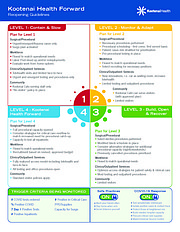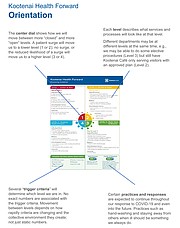Kootenai Health launches recovery plan
MIKE PATRICK | Hagadone News Network | UPDATED 5 years, 7 months AGO
COEUR d’ALENE — Kootenai Health isn’t used to losing money.
North Idaho’s largest employer, boasting an army of 3,600 people, has seen unprecedented growth fueled by the vision of CEO Jon Ness since his hiring 10 years ago. Fiscal report cards have been stellar.
“We have consistently exceeded our annual budget goals. Our history is one of stability,” said Ness. “We’ve been A-rated by Standard & Poor’s. So this is a very unusual period of time for us because we lost money in March, we’ll lose money in April, probably the same in May, probably a little bit the same in June.”
As of late last week, the damage looked like $7 million lost in the last couple weeks of March followed by a $12 million-$15 million loss in April.
Reflecting those losses is the fact that while Kootenai Health hasn’t had to dip into the layoff well, more than 500 employees have taken voluntary furloughs lasting between a day here and there to a full month off work.
Ness can hardly wait for recovery — realistic, admittedly moderate recovery.
“In spite of all the unknowns, we think a reasonable target for this year is to break even,” he said. “That’s not where we’ve been in the past at all... but if we could break even, it creates for us a runway into 2021. We think the impact of this is not going to be felt just this year. We believe it will carry into 2021 and maybe beyond that.”
The impact showed on the somewhat strained faces of Ness, CFO Kimberly Webb, human resources VP Danny Klocko and communications/marketing director Kim Anderson during a web-facilitated interview with The Press last Thursday. This was not an all-smiles press conference announcing a multi-million dollar hospital expansion, admission into the Mayo Clinic family, a new emergency department or a plum acquisition. It was more a reckoning with some 160,000 Kootenai County shareholders of the community-owned hospital.
Despite so many unknowns from the havoc wreaked by novel coronavirus, Ness has certainty on several fronts.
One is that your property taxes will not increase to make up the Kootenai Health shortfalls.
“Every year the [hospital district] board is asked if Kootenai Health is intending to use its taxing authority,” Ness said. “For the 25th year in a row, the board has decided not to use its taxing authority, for fiscal year 2021.”
Not that exercising those tax-collecting muscles would come close to solving the problem anyway.
“There’s a big urban myth about this,” Ness said, explaining that the current tax rate would be based on the last time it was used: In this case, 1995. “It was like $455,000 or so.”
Another certainty: Kootenai Health’s board and its on-the-ground leadership team isn’t waiting for come what may.
“We do best at Kootenai Health when we have a plan,” Ness said with a rare smile. “I feel really good about our leadership’s ability to execute plans.
“When the governor came out with the four-stage opening of Idaho, we took that document and asked ourselves the question: Would it be helpful to have our own staged opening plan? Then we asked ourselves how we could simplify the message. We came up with this Kootenai Health Forward Reopening Guidelines document.”
Phase 1 was Contain and Slow.
“We really started in that phase to expand televisits, which I think is going to be here to stay,” Ness said. “I think a lot of patients and providers like that model.
“In some ways that phase would be best described as a phase of testing, learning, adapting and kind of starting to reimagine health care in the future.”
Now, Ness said, the organization is in Phase 2 shifting to Phase 3, “which is reopen Kootenai Health in a safe, appropriate way and begin the process of financial recovery.”
In some ways, Ness said, that phase will last months.
“Then we move to my favorite phase, which is where we’re back at full operations,” he said. “We think it’ll take some time to get there, but this is actually where you start to kind of reimagine health care and say, ‘What did we learn? Not only are we recovering but we’re improving our operation — much more streamlined, much more patient-friendly, and really be innovative and creative about the new Kootenai Health going forward.’”
Webb, the CFO, said physicians are determining essential procedures that can be done as soon as operating rooms reopen, providing key services to the community and cash flow to the hospital.
“We are definitely ramping up,” she said.
Perhaps the greatest uncertainty out there, however, is this: What if the hospital gets back on track and there’s a COVID-19 surge?
The Kootenai Health Forward plan is built for that.
“This dial in the middle suggests it’s not a switch,” Ness said, pointing at the chart included with this article. “This four-level approach, if we have a surge of coronavirus patients, we can dial it back and go back to Level 1. That’s not where we want to go, but this methodology allows us to go back to different levels depending on the status of the health community.
“We’re pretty pleased with this approach. Just yesterday (May 6), the Idaho Hospital Association sent the Kootenai Health Forward reopening guidelines to every hospital CEO in the state of Idaho as an example.”
Added Webb: “If we do get a surge, because of all the work we’ve done, we’ll be able to isolate those patients and continue to provide normal services in a safe manner — all because of this work we’ve done in the past six weeks.”
Anderson, the communications director, explained how basic patient testing improvements will have a profound effect moving ahead.
In the early days of the coronavirus, tests took more than four days to get results. The entire time, she said, “you have to treat a person as though they’re a positive patient for COVID, which means every single interaction with that patient, all of the staff have to be appropriately gowned and gloved and using those resources. Just the ability to test someone and get those results back quickly is going to reduce the need for that personal protective equipment that became such a barrier early on.”
Ness said testing now takes less than two days and, on a very limited basis, can sometimes be done in less than six hours.
Kootenai Health is also better positioned for a surge based on modeling it’s done, said Webb, pointing out that the hospital bought monitors to ensure the hospital has enough equipment to take care of a big influx of patients.
“All models have flaws, and there’s always changing information, but we looked at an average daily census,” she said. “If there was a surge, the worst case scenario would be 125 patients a day. With everything we have in place, we could easily take care of that number of patients and have enough ventilators.”
That 125 number would cover not just Kootenai County, but all of North Idaho “and even overflow from Spokane if that occurred,” she said.
“Our working assumption is that we are prepared for the worst-case scenario,” Ness said.
While nobody can say for sure that the worst is over, Ness put the pandemic into perspective, with a clear turning point and hope for the future.
“I think the thing that’s scary about this situation is that unlike other diseases we’ve experienced in our nation’s and world’s history, at this moment there is no vaccine or therapeutic treatment,” he said. “That’s the scary thing about this.”
He said the federal government is putting “extraordinary resources” behind treatment and vaccine research and development.
“It’s at that point that consumer and economic confidence will really turn for the positive,” Ness said. “Of course that’s outside the control of Kootenai Health or Panhandle Health District or the state of Idaho, but that’s the real turning point in this. And that’s the real reason when we look at this situation, and we’re trying to be realistic and pragmatic about it, our view is that this is not a quick, short problem. This is a situation that will continue into next year. But it will make a remarkable difference when vaccination and therapeutic treatments are available for patients.”
Meantime, while there’s no pill for a quick cure, there is a plan in place to forge ahead.
“The economics of this has been very challenging,” Ness said. “We’re understanding and sympathetic about that. I am absolutely confident that Kootenai Health is going to come back, recover and do very well in the future. But that’s a little longer journey.”
ARTICLES BY MIKE PATRICK

Anonymous old friend gives CFA big boost
Once again, Anonymous in Athol comes through - and issues challenge.

Newspaper prank adored and abhorred
For 18th consecutive year, spoof entertains Press readers
For 18th consecutive year, spoof entertains Press readers.

Fulcher: Prepare for turbulence
Congressman says war impact will be felt here
Argues that US should "choke off" Putin by ramping up energy production and export to friendly nations.





